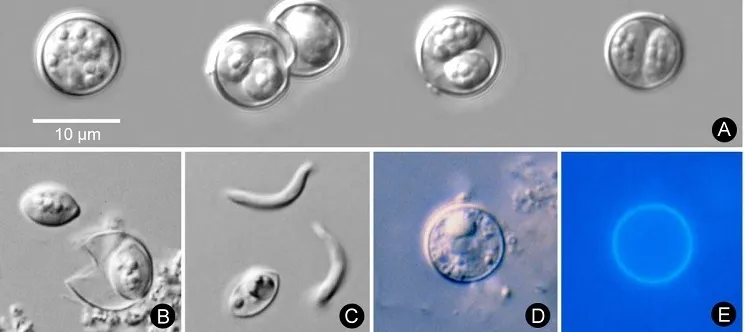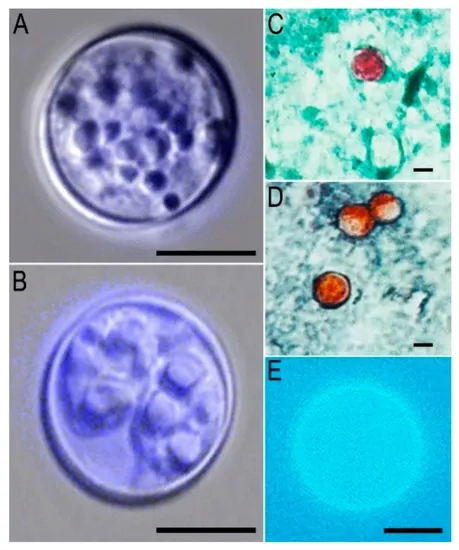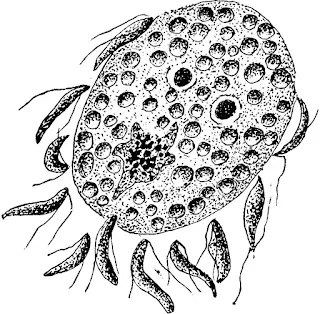Introduction
Cyclospora cayetanensis is an intracellular protozoan sponger that
causes the illness known as cyclosporiasis. This arising pathogen
has gained attention in recent times due to its capability to beget outbreaks of
gastrointestinal illness in colorful corridor of
the world. The infection is primarily transmitted through
the consumption of defiled food and water, and it affects
millions of people annually, particularly in developing countries with poor sanitation systems.
In this composition, we will explore the characteristics of
Cyclospora cayetanensis, its mode of transmission, clinical instantiations, opinion,
and forestallment strategies.
1. Characteristics of Cyclospora cayetanensis
Cyclospora cayetanensis is a single- celled sponger belonging to
the phylum Apicomplexa. It was first linked in the 1970s
but gained recognition as a mortal pathogen in the 1990s
when it was associated with several foodborne outbreaks.
The sponger exists in the terrain as an oocyst, a dormant and flexible stage that
allows it to survive in harsh conditions. Oocysts are exfoliated in
the feces of infected individualities and can pollute water
and food sources.
2. Mode of Transmission
The primary mode of transmission of Cyclospora cayetanensis is
through the consumption of defiled food or water. The oocysts
are ingested, and formerly inside the mortal host,
they suffer sporulation, releasing sporozoites that foray the
intestinal epithelium. defiled yield, similar as fresh fruits and
vegetables, has been intertwined in multitudinous outbreaks,
as oocysts can cleave to the face of these particulars. also, polluted water sources, including recreational
waters, can also serve as a vehicle for transmission.
3. Clinical instantiations
After ingestion, it takes several days for the oocysts to sporulate
and release the sporozoites, which also foray the small intestine.
The infection primarily affects the gastrointestinal tract,
causing symptoms similar as watery diarrhea, abdominal
cramps, bloating, nausea, and fatigue. Some individualities may witness puking, low- grade fever,
and weight loss. The inflexibility and duration of
symptoms can vary, with some cases being mild and tone- limiting,
while others may persist for several weeks or months, leading to significant debilitation.
4. Opinion
The opinion of Cyclospora cayetanensis infection is challenging due
to the bitsy size of the oocysts and the intermittent shedding
of the sponger in the coprolite. Specialized laboratory ways, similar as
acid-fast staining and modified acid-fast staining,
are frequently used to identify the oocysts. still,
these styles may not always give definitive results.
Molecular ways, similar as polymerase chain response (PCR),
can be employed for more accurate discovery and isolation of
Cyclospora species.
5. Prevention Strategies
Precluding Cyclospora cayetanensis infection involves enforcing several strategies at colorful situations.
At the individual position, rehearsing good hygiene, similar as proper handwashing
with cleaner and water before handling food, is pivotal.
It's also important to wash fruits and
vegetables completely, particularly those that are consumed raw.
In regions where Cyclospora is aboriginal, proper treatment
and operation of wastewater and sewage systems are essential to help environmental impurity.
Likewise, the food assiduity should cleave to strict hygiene practices and apply applicable protocols
to minimize the threat of impurity during food product,
processing, and running. Regular monitoring and testing of Water sources and agrarian products can help identify implicit outbreaks and help the distribution of defiled food particulars.
Comparison between Cyclospora cayetanensis and E. coli
Cyclospora cayetanensis and E. coli are two different types of
pathogens that can beget intestinal illness in humans.
Cyclospora is a protozoan sponger, while E. coli is a bacterium. Both
pathogens can be spread through defiled food and
water, and they can beget analogous symptoms, similar as
diarrhea, puking, and abdominal cramps.
Cyclospora cayetanensis
Cyclospora cayetanensis is a bitsy sponger that can infect
the small intestine. It's set up worldwide, but it's
most common in tropical and tropical regions.
People can come infected with Cyclospora by consuming food or
water that has been defiled with the sponger's oocysts (eggs).
The oocysts can survive for several weeks in water and soil, so they
can be a source of infection indeed in areas where
the sponger isn't presently aboriginal.
The symptoms of cyclosporiasis generally appear 1- 2 weeks after
infection. They can include watery diarrhea, loss of appetite, weight loss, stomach cramps,
bloating, nausea, and fatigue. Some people may also witness puking, fever,
and headache. The symptoms of cyclosporiasis can last for
several weeks, indeed with treatment.
E. coli
E. coli is a type of bacteria that's set up in the bowel of
humans and creatures. There are numerous different strains
of E. coli, some of which are inoffensive, while others can beget illness.
The strains of E. coli that are most likely to beget illness are
those that produce poisons. These poisons can beget diarrhea, puking,
and abdominal cramps.
E. coli can be spread through defiled food and
water, as well as through contact with the feces of an
infected person. The symptoms of E. coli infection generally appear 1-
3 days after infection. They can last for several days, indeed with
treatment.
Cyclospora cayetanensis and E. coli are both pathogens that can beget intestinal illness in humans. These infections can have a significant impact on health, both physically and emotionally.
Physically, cyclosporiasis and E. coli infection can beget a variety of
symptoms, including diarrhea, puking, abdominal cramps,
bloating, nausea, fatigue, puking, fever, and headache.
These symptoms can be severe and can lead to dehumidification,
electrolyte imbalances, and other complications. In some cases,
cyclosporiasis and E. coli infection can indeed be fatal.
Emotionally, cyclosporiasis and E. coli infection can be veritably disruptive.
The symptoms can make it delicate to eat, sleep,
and work. They can also lead to anxiety, stress,
and depression.
In addition to the physical and emotional goods,
cyclosporiasis and E. coli infection can also have a fiscal impact.
The cost of medical care, lost stipend, and other charges can be significant.
It's important to take way to help cyclosporiasis
and E. coli infection. This includes rehearsing good hygiene, cooking food completely,
and avoiding drinking water that you aren't sure is safe. However, see a croaker right down,
If you suppose you may have been infected.
Then are some fresh tips for precluding cyclosporiasis
and E. coli infection
Wash your hands frequently with cleaner and
water, especially after using the restroom, changing diapers,
and before eating.
Avoid swimming in or drinking water that may be defiled.
Cook food completely before eating it.
Wash fruits and vegetables completely before eating them.
Avoid eating raw or undercooked meat.
If you're traveling to a country where cyclosporiasis or E.
coli is common, be sure to take preventives to cover yourself.
|
Characteristic |
Cyclospora
cayetanensis |
E. coli |
|
Type |
Protozoa |
Bacteria |
|
Symptoms |
Watery diarrhea, loss
of appetite, weight loss, stomach cramps, bloating, nausea, fatigue,
vomiting, fever, headache |
Diarrhea, vomiting,
abdominal cramps |
|
Transmission |
Contaminated food and
water |
Contaminated food and
water, contact with the feces of an infected person |
|
Incubation period |
1-2 weeks |
1-3 days |
|
Duration of
symptoms |
Several weeks |
Several days |
Conclusion
Cyclospora cayetanensis is a significant arising parasitic
pathogen that poses a trouble to public health encyclopedically.
Its capability to beget outbreaks of
gastrointestinal illness through defiled food and
water highlights the significance of robust forestallment and control measures. Increased mindfulness among
healthcare professionals, bettered individual ways, and strengthened surveillance systems are necessary to
effectively manage and alleviate the impact of
cyclosporiasis. also, continued exploration into the sponger's
biology, transmission dynamics, and implicit treatment options is pivotal for developing targeted
interventions and reducing the burden of this arising contagious complaint.






